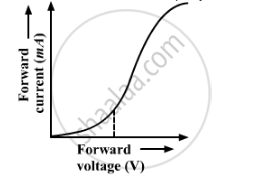Advertisements
Advertisements
प्रश्न
Using the necessary circuit diagrams, show how the V-I characteristics of a p-n junction are obtained in
Forward biasing
How are these characteristics made use of in rectification?
उत्तर
p-n junction diode under forward bias

p-side is connected to the positive terminal and n-side to the negative terminal.
Applied voltage drops across the depletion region.
Electron in n-region moves towards the p-n junction and holes in the p-region move towards the junction. The width of the depletion layer decreases and hence, it offers less resistance.
Diffusion of majority carriers takes place across the junction. This leads to the forward current.
The V-I characteristics of p-n junction in forward bias is shown below:

APPEARS IN
संबंधित प्रश्न
Colour of light emitted by LED depends upon__________________ .
- its forward bias
- its reverse bias
- the band gap of the material of semiconductor
- its size
If a small voltage is applied to a p-n junction diode, how will the barrier potential be affected when it is (i) forward biased
Write briefly the important processes that occur during the formation of p−n junction. With the help of necessary diagrams, explain the term 'barrier potential'.
Why is zener diode fabricated by heavily doping both p- and n-sides of the junction?
How does a light emitting diode (LED) work? Give two advantages of LED’s over the conventional incandescent lamps.
With reference to Semiconductor Physics,
Name the process that causes depletion region in a p-n junction.
Explain photodiode.
For LED's to emit light in visible region of electromagnetic light, it should have energy band gap in the range of:
Why a photo-diode is operated in reverse bias whereas the current in the forward bias is much larger than that in the reverse bias? Explain. Mention its two uses.
What energy conversion takes place in a solar cell?
